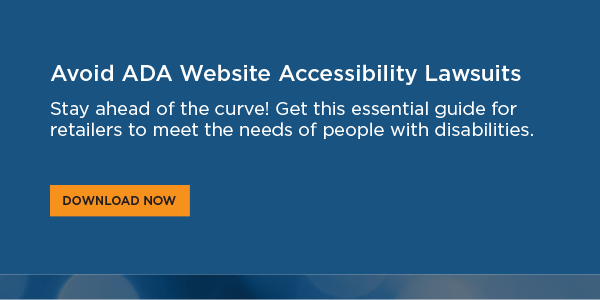While it's generally accepted that web accessibility is a legal necessity and moral imperative, it's also an enormous economic opportunity. Some estimate that the global market of people with disabilities is approaching 1.3 billion, the majority of whom are Baby Boomers—currently the wealthiest generation.
Here are five ways tending to digital accessibility will help your bottom line:
Boost Brick-and-Mortar Sales
You work hard to provide a remarkable experience for every customer. Your website represents an opportunity to do the same. Younger and older generations alike of all abilities crave an in-person retail experience.
Companies that excel in both spaces see higher revenues and profitability. Home Depot and Best Buy are two examples of this strategy at work—both grew their profits last year without adding any new stores.
Delivering an accessible website ensures you can serve your brick-and-mortar customers now and in the future.
Welcome All Customers
The digital retail market is on the move, to the tune of more than 1.6 billion people who purchased goods online in 2016. According to one study, users with disabilities accounted for as many as 10 percent of all online sales. Ignore accessibility, and you could be ignoring these potential customers.
The main objection to this argument is predictable—”but people with disabilities don’t use our services/products.” This statement is, in most cases, untrue. Practically every business has customers who have a disability. And for many, online shopping is an essential window to the larger retail world. If your site provides a user-friendly experience, they will keep coming back.
Enhance Your Brand Value
In November of 2018, Forbes cited a study of 1,000 Americans, which noted the following trends:
- 87 percent of consumers will purchase a product from a company that advocates for issues important to them.
- 88 percent will show more loyalty to a business that support environmental or social issues and 92 percent are more likely to trust that business.
Corporate social responsibility is a key part of accessibility strategy and we see these trends play out every day for a wide variety of companies. Your website accessibility policy is an opportunity to create a positive change in the company culture, and to increase business and customer loyalty.
Deliver Remarkable Customer Service
A fully accessible site is, by its nature, easier to navigate. Your company can communicate with customers more easily, and important information will be at their fingertips.
It’s also worth noting that an accessible site today can attract and provide for customers who develop a disability tomorrow. Baby boomers losing their sight and whose fingers are less dexterous than they once were will appreciate a fully-accessible online experience.
Simplify Online Ordering
Your accessible online store also optimized to attract new ones. Search engines love good structure, and when your information is properly labeled and images are paired with accurate descriptions, they will bump your results up accordingly.
Achieving this ideal structure requires asking some basic questions:
- Do customers need a login to access your site? Are the password requirements laborious and counterintuitive?
- Is your cart user-friendly? How easy is it to update quantities or take out items?
- Are forms programmed correctly, or do they require frustrating combinations of keystrokes or screen reader interactions?
- Does your site make users retype payment and shipping addresses, even when they’re the same?
- When customers get an error message, is it easily understandable? Does it stop the sale? Do they have to start all over again?
Make an Exceptional App
Shoppers are using their phones to browse and buy in ever-growing numbers. And there are many circumstances when a user without a disability may find accessible features helpful, whether it’s poor contrast at the beach or a bumpy ride in the car.
A few ways to maximize your app’s accessibility:
- Design for small screen size.
- Ensure accurate touch target size and placement.
- Make data entry easy.
- Focus on color contrast.
- Minimize custom gestures.
- Create consistent layouts.
To dive deeper into this topic, consult our blog series on accessible app design.
Time to Get Started
A comprehensive accessibility plan can put your company on the path to increased sales, connections with valuable new customers, and a streamlined digital experience. Learn more in our free guide.







